As businesses grow, it becomes increasingly important to focus on employees who help to make it all possible. Employee satisfaction plays a crucial role in the success of any organization, as happy and engaged employees are more productive, creative, and loyal. When organizations make employees feel valued, they are more likely to go above and beyond in their roles, leading to improved overall performance and better business outcomes.
In this blog, we’ll explore the many facets of employee satisfaction, including why it’s important, how to measure it, strategies for improving it, and the role technology can play in all this.

What is employee satisfaction and why is it important?
Employee satisfaction, in its most basic form, refers to how satisfied, fulfilled, and happy an employee is with their job and overall working experience. Employee satisfaction is often an indicator of an employee’s engagement, happiness, and well-being levels at work. High levels of employee satisfaction often translate into lower absenteeism and turnover, increased productivity, and better job performance.
Work stress, work-life balance, fair compensation, the manager-employee relationship, work culture, growth and learning opportunities, job security, and teamwork are all important factors to consider when talking about employee satisfaction.
Employee satisfaction is important because it has a direct impact on business performance and profitability. According to a study by the University of Warwick in Coventry, England, happy employees were 12% more productive than unhappy employees on average. That productivity stretched as high as 20% above a control group. To continue, below are a few benefits that employee satisfaction can reap for your organization:
Lower turnover rates:
Happy and satisfied employees do not tend to leave their jobs due to a slight inconvenience. This translates to decreased employee turnover as well as lower expenses on hiring and recruitment processes.
Higher productivity levels:
Employees who are satisfied do not require external motivation to do their job at their best. They have an innate sense of dedication that drives them to take over new challenges and step beyond their defined role to complete a task.
Work culture:
Satisfied employees build a strong and happy professional environment, improving the overall culture of the company. A positive work culture can further attract other qualified candidates and promote productivity as well as brand image.
Improved loyalty:
High employee satisfaction breeds loyalty to the company. Employees who feel that their jobs are fulfilling and their employers value them will strive to support the company’s mission.
Enhanced brand image:
You will boost employee morale by creating a positive and nurturing workplace atmosphere. Your existing employees will advocate for your employer brand, which will attract more high-caliber talent to join your organization.
Difference between employee satisfaction and employee engagement
| Employee Satisfaction | Employee Engagement | |
| Definition | The level of contentment an employee feels about their job and working conditions. | The level of involvement, enthusiasm, and commitment an employee feels towards their job and the organization. |
| Outcome | Positive attitude and emotional well-being. | Active participation, effort, and productivity. |
| Measurement | Employee satisfaction surveys, exit interviews, turnover rates. | Employee engagement surveys, absenteeism rates, productivity measures. |
| Importance | An important factor for retaining employees and creating a positive workplace culture. | A critical factor in driving organizational success and achieving business goals. |
| Relationship | Satisfaction can lead to engagement, but not always. | Engagement can lead to satisfaction, but not always. |
Factors that influence employee satisfaction
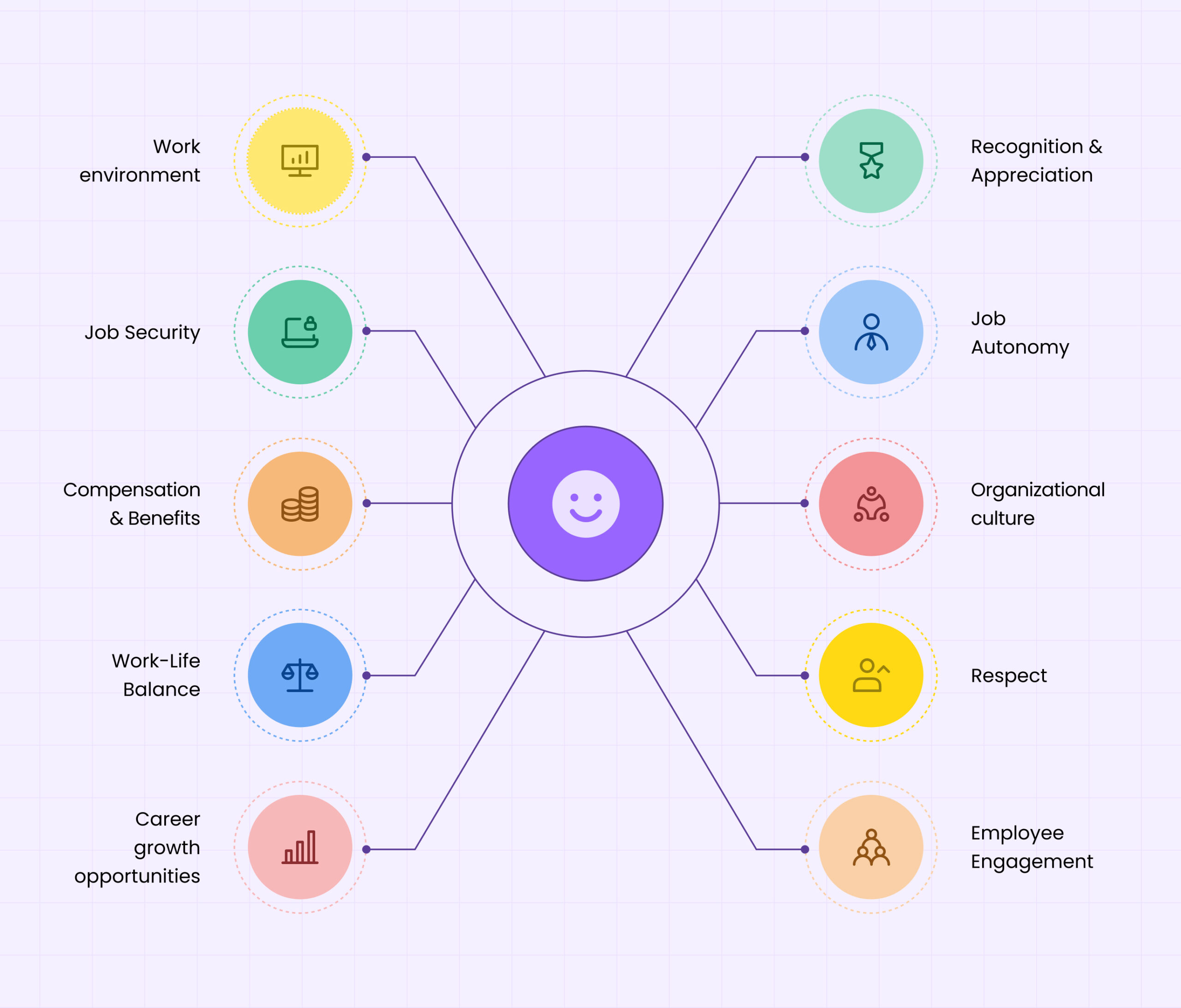
There are many employee satisfaction factors, but some of the main ones include:
 Work environment:
Work environment:
An organization’s working environment has a significant impact on employee satisfaction. A positive and supportive work culture that values teamwork, inclusivity, and open communication can foster employee satisfaction and engagement.
 Job security:
Job security:
A sense of job security and stability is one of the main employee satisfaction factors. It can also positively influence employee satisfaction, reducing stress and anxiety related to job loss or insecurity.
 Compensation and benefits:
Compensation and benefits:
Employees expect fair and competitive compensation, along with a comprehensive benefits package that includes healthcare, retirement, and other perks.
 Work-Life balance:
Work-Life balance:
A balance between work and personal life is essential for employee satisfaction. Flexibility in working hours and leave policies can help achieve this balance.
 Career growth opportunities:
Career growth opportunities:
Employees who feel that they have opportunities for professional development and advancement are often more satisfied with their jobs.
 Recognition and appreciation:
Recognition and appreciation:
Appreciation and recognition at the workplace is one the key drivers of employee happiness and an important employee satisfaction factor. Regular feedback, recognition, and appreciation for a job well done can significantly impact employee morale and motivation.
 Job autonomy:
Job autonomy:
The level of control and decision-making power employees have over their work can significantly impact their job satisfaction.
 Organizational culture:
Organizational culture:
A positive workplace culture that values open communication, collaboration, and respect can foster a sense of belonging and satisfaction among employees.
 Respect:
Respect:
Employees must feel respected and acknowledged at work. When employees are rewarded for their efforts, it motivates them to continue doing their best for themselves and the organization.
 Employee engagement:
Employee engagement:
Employee engagement and work happiness are commonly related. When there is no engagement with work duties, contentment declines, making this component essential for a better workplace experience.
Metrics to measure employee satisfaction
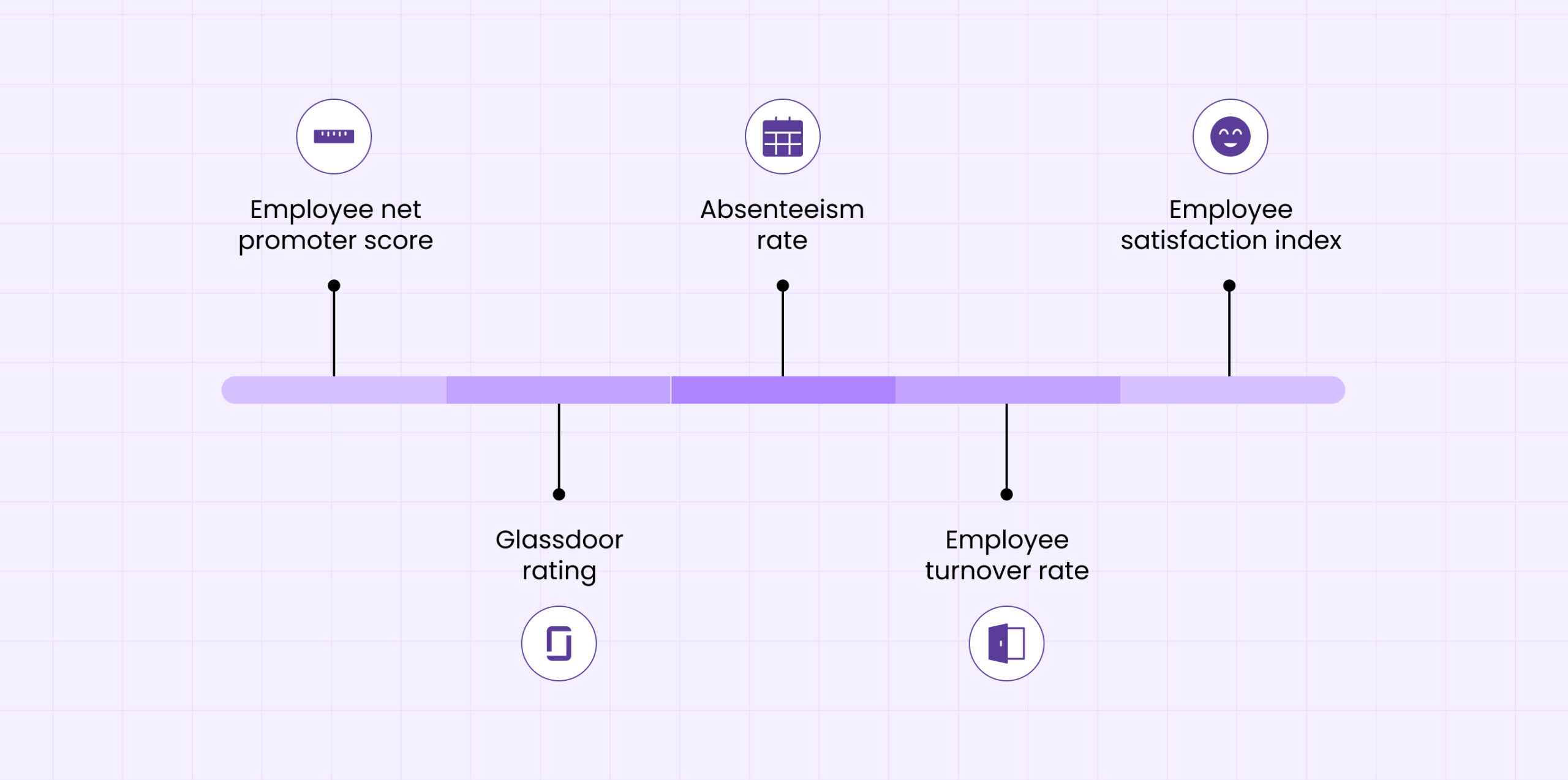
By now we have established that monitoring employee satisfaction metrics is crucial for your business. But you need to focus on the right KPIs for the best results.
Here are some of the employee satisfaction metrics you should measure frequently:
 Employee net promoter score
Employee net promoter score
The most popular way to measure employee satisfaction is the eNPS, it shows how likely your employees are to promote your employer brand.
Companies determine this score by asking employees questions like “On a scale from 1 to 10, how likely are you to recommend this company as a place to work?” or “Based on your experience, how likely are you to recommend our organization to an acquaintance?”
Based on the gathered data, you can break it down into the following three parts:
- Promoters: A score between 9 to 10 signifies employee satisfaction in their respective job positions.
- Passives: Employees who give ratings between 6 to 8 are neither unhappy nor very happy. These are the neutral members of your workforce.
- Detractors: Any rating below 6 signifies an employee’s dissatisfaction with their job.
The formula used to determine eNPS is:
eNPS = Percentage of promoters – Percentage of Detractors
Your employee satisfaction rate is okay if your calculated eNPS is above 0. Anything under -10 is a matter of concern.
 Glassdoor rating
Glassdoor rating
Employee satisfaction has a tremendous impact on your employer brand. We live in a digital age where prospective job candidates will google you before you interview them.
One of the most popular employer review sites is Glassdoor. Therefore, one of the best ways to measure employee satisfaction is by tracking reviews on Glassdoor.
The platform’s algorithm emphasizes the most recent reviews to give an up-to-date satisfaction score of the company. The ratings are based on employee feedback on a 5-point scale:
- 0.00 – 1.50 employees are “Very Dissatisfied”
- 1.51 – 2.50 employees are “Dissatisfied”
- 2.51 – 3.50 employees say it’s “Okay”
- 3.51 – 4.00 employees are “Satisfied”
- 4.01 – 5.00 employees are “Very Satisfied”
 Absenteeism rate
Absenteeism rate
Absenteeism can show weak leadership, poor management, lack of work-life balance, and poor working conditions. A high absenteeism rate causes a more significant workload, adding to the stress and negatively impacting employee satisfaction.
To calculate the absenteeism rate in your company, use the following formula:
Absenteeism rate = Number of absent days in a given period / Number of available work days in that period
 Employee turnover rate
Employee turnover rate
A dissatisfied employee is more at risk of leaving their current organization. High turnover is costly and disrupts the whole workflow.
Better employee satisfaction leads to a lower turnover rate. Calculating employee turnover will give you an accurate insight into your employee satisfaction strategy.
Turnover rate = Number of attritions during a period / Number of employees at the beginning of that period
 Employee satisfaction index
Employee satisfaction index
Another way to measure employee satisfaction levels in quantifiable terms is through the employee satisfaction index. To determine the employee satisfaction index or ESI, companies usually ask three primary questions:
- How well does your workplace meet your expectations?
- How close is your workplace to your ideal job?
- How satisfied are you with your workplace?
The rating scale here is 1 to 10. The formula used to calculate ESI from the collected data is:
ESI= [{(Question mean value/3) -1} /9] X 100
The calculated ESI will show a score between 0 to 100. The higher the Number, the more satisfied your employees are.
How to measure employee satisfaction?
Here are some of the best ways to measure employee satisfaction rates and gather data at your organization:
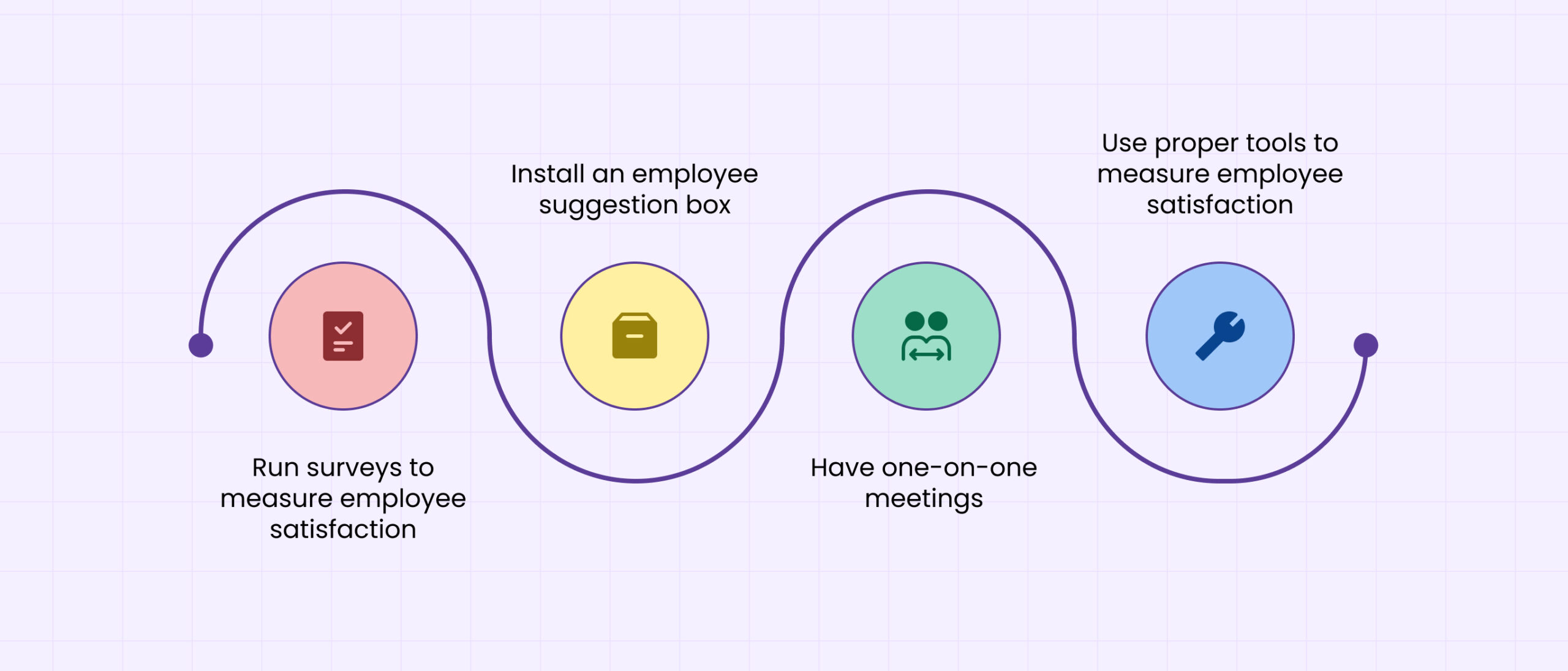
 Run surveys to measure employee satisfaction
Run surveys to measure employee satisfaction
Your employees are the best people to tell you what they need. Thus, to get an accurate baseline measurement of employee satisfaction, conduct frequent and routine employee satisfaction surveys.
Surveys to measure employee satisfaction should be brief with precise questions. Include options to select as answers. You can also have scales. For example, “Are you happy with the opportunities for growth available in the company? (Rate from 1 to 10)”.
Mix some open-ended questions in the survey to get a more detailed picture. For example, “How would you improve work distribution in your team?”
However, routinely sharing these surveys to measure employee satisfaction becomes quite tricky with manual methods. Leena AI offers automated and effective employee satisfaction surveys that maximize participation and gather the most conclusive data. This helps you gauge employee satisfaction.
 Install an employee suggestion box
Install an employee suggestion box
Your employees have plenty of valuable suggestions for the company. However, expressing them publicly can come across as intimidating.
Installing suggestion boxes in the office allows them to share their opinions and ideas anonymously.
It is an excellent way to encourage employees to voice their opinions and concerns without fearing judgment. You will collect data without waiting to ask them questions.
 Have one-on-one meetings
Have one-on-one meetings
To collect accurate employee-specific data, frequently conduct one-on-one meetings with your workers. These meetings usually have a duration of 20 to 30 minutes. You can adjust this according to your requirements.
Ask about the employee’s mental health, how they are dealing with the workload and stress and what problems they face at the workplace.
Ask follow-up questions like:
- Is there a task or activity you want to spend more time on?
- Do you have the proper equipment to perform your duties?
- Do you have any suggestions for processes we could improve?
 Use proper tools to measure employee satisfaction
Use proper tools to measure employee satisfaction
Manual methods of collecting data are time-consuming and prone to errors. This will hamper the entire process and give you inconclusive results.
To prevent that, use automation tools to measure employee satisfaction in your organization. Advanced software like Leena AI will conduct frequent employee surveys and provide specific data sets.
The advanced analytics will dig deep and decipher the sentiments between employee opinions and suggestions. The software is scalable and would help you maintain a consistent employee satisfaction rate.
How can you improve employee satisfaction?
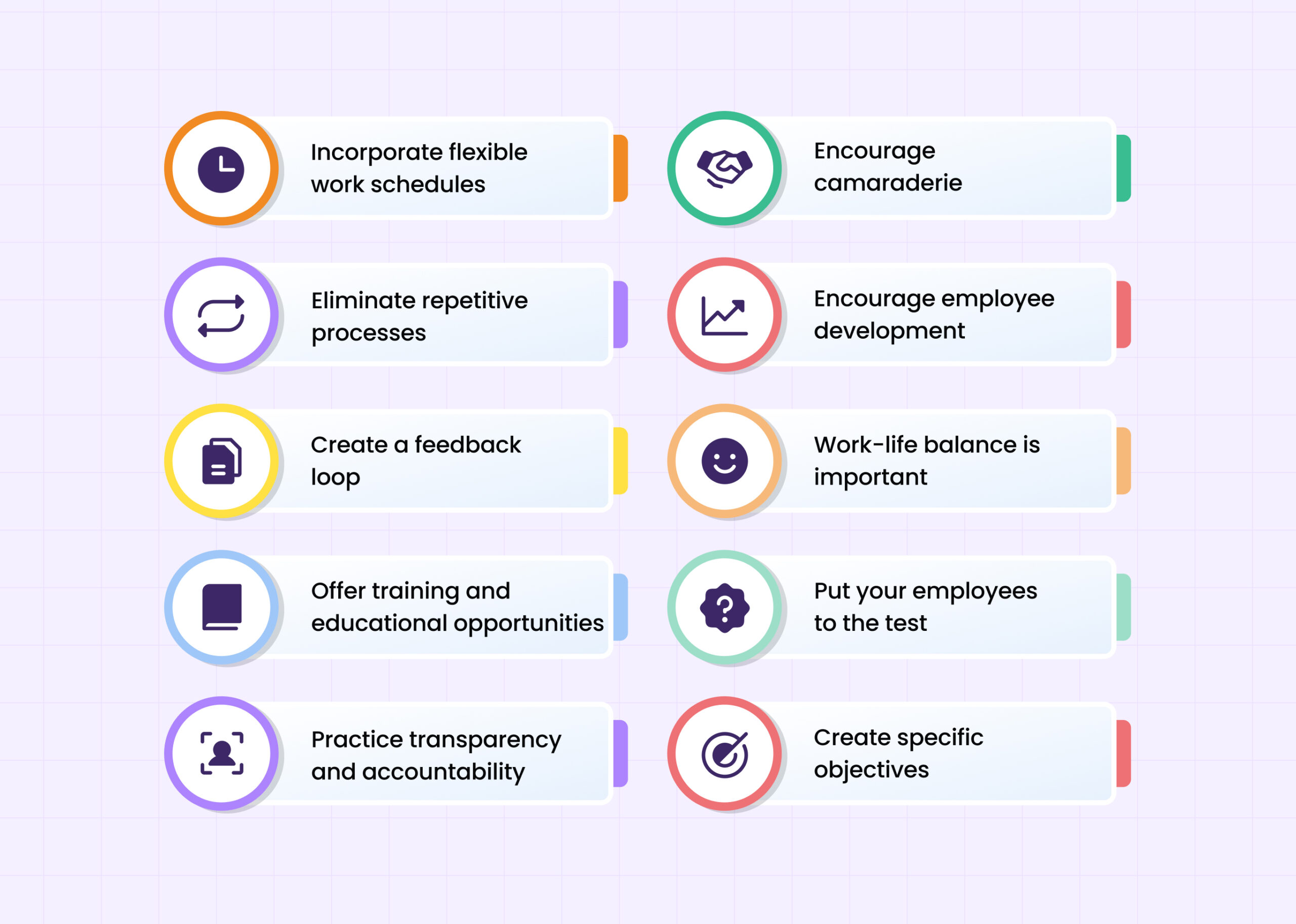
You can take various ways to improve the employee satisfaction rate at your organization. Here are a few points to keep in mind:
 Incorporate flexible work schedules:
Incorporate flexible work schedules:
If work schedules are hampering the work-life balance of your employees, consider becoming more flexible with the work hours. Giving them leeway offers them autonomy, reduces work stress, and even improves productivity.
 Eliminate repetitive processes:
Eliminate repetitive processes:
If the data shows your employees waste much time at work, chances are your operations need to be properly streamlined. Ditch manual methods to perform repetitive tasks and opt for automation to prevent that. This would free up a sizable chunk of their time and allow them to focus on more strategic tasks.
 Create a feedback loop:
Create a feedback loop:
Listening to your employees is one of the finest ways to understand your company’s culture and current employee satisfaction levels. When given the chance, many employees are eager to express their thoughts about the organization for which they work.
 Offer training and educational opportunities:
Offer training and educational opportunities:
Provide training and educational courses to help them broaden their horizons. This will help them become more confident and motivate them to climb the corporate ladder. When you show them you prioritize growth, they feel valued, and employee satisfaction improves.
 Practice transparency and accountability:
Practice transparency and accountability:
The key to employee satisfaction is to make your employees feel like a part of the family. Be transparent and share major milestones and company decisions with your teams.
 Encourage camaraderie:
Encourage camaraderie:
Employees who are involved in the workplace community are more satisfied with their jobs. To boost employee satisfaction, encourage employees to get to know one another and create ties through social outings and work-sponsored events.
 Encourage employee development:
Encourage employee development:
Employers who encourage employee development are also investing in their company’s future by training the talents of future supervisors or managers.
 Work-life balance is important:
Work-life balance is important:
When a company cherishes its employees’ personal time, people may tackle personal concerns while away from work and focus better on their obligations when on the job.
 Put your employees to the test:
Put your employees to the test:
Continue to challenge staff by setting new goals every week or month, then praising their accomplishments or building stronger action plans to reach those goals.
 Create specific objectives:
Create specific objectives:
Another important key to employee satisfaction is to have clear, realistic timetables for short- and long-term goals. Also, check in with employees on a regular basis, whether through a brief meeting or a thorough performance review, to ensure that they are confident in their skills to achieve them.
Role of technology in employee satisfaction
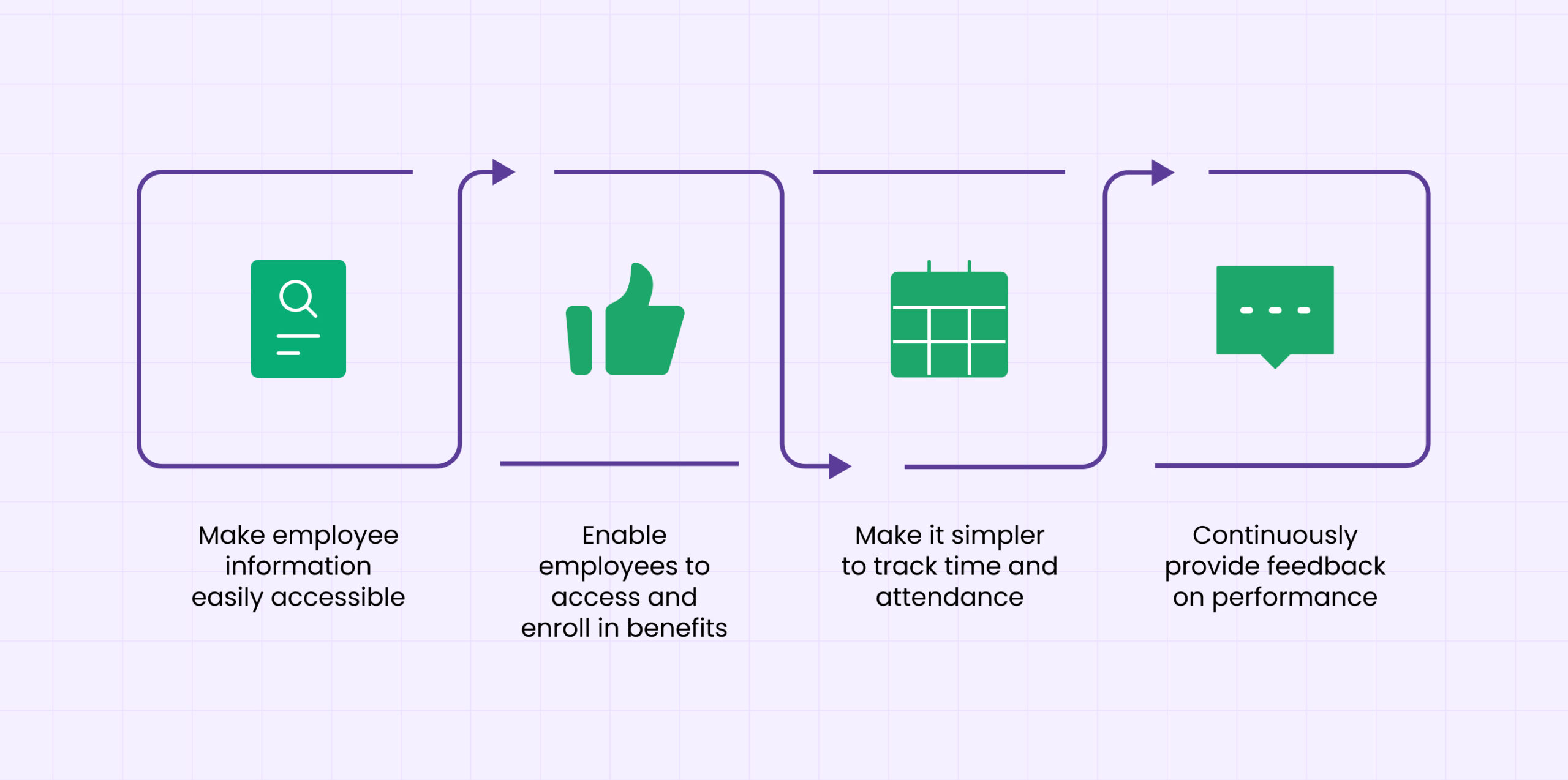
Technology is a critical component of the employee experience. Technology may either assist people in doing their best job or be a hindrance that frustrates and slows them down. The purpose of technology is to make work and the interactions that go with it easier. Excellent technology can promote employee engagement and contribute to pleasant attitudes about work, lowering attrition and increasing customer satisfaction.
 Make employee information easily accessible
Make employee information easily accessible
Your employees’ pay history and personal information, such as contact information, must be safe. Employees should be able to handle their information 24 hours a day, seven days a week utilizing self-service payroll, which lets them to view and print payslips, bank transfer advice stubs, and personalized reports. This system should also allow employees to modify their banking details.
 Enable employees to access and enroll in benefits
Enable employees to access and enroll in benefits
Employees should be able to access and enroll in benefits from the comfort of their own homes. According to studies, many employees choose self-service solutions for benefit registration because they enable them to make informed choices with the assistance of their loved ones. Providing more resources and assistance to employees might assist them in feeling more secure in their judgements.
 Make it simpler to track time and attendance
Make it simpler to track time and attendance
Make self-service solutions available to help with attendance and time tracking. Workers can utilize their mobile phones to clock into and out of work, request time off ahead of time, and check their PTO balances, leading to more accurate tracking.
 Continuously provide feedback on performance
Continuously provide feedback on performance
Use self-service technologies in work performance to provide continuous feedback to employees. Managers can use this to keep employees engaged and satisfied with their jobs. A Human Capital Management (HCM) system can assist you in organizing and managing essential facts, taking notes, and providing supporting documentation for employees to view.
Employees can become more connected to your company when they use HR self-service technology. Empower employees to be accountable for their own information, to seek solutions, and to solve problems.
Conclusion
Employee attitudes towards work are important, and their experiences can have a positive or negative impact on your company’s bottom line. Your workforce is the pulse of your organization. To sustain success and scale your business, you must offer them a comfortable environment accommodating productivity.
The effectiveness of your initiatives depends on how accurately you measure employee satisfaction in your organization. Whether you focus on Glassdoor reviews or prioritize the eNPS score, you must act on the gathered insights.
This needs accuracy and efficiency, which you can’t expect from manual methods. This is where scalable and effective employee satisfaction software comes in handy.
Besides the intelligent pulse surveys, Leena AI offers the finest analytical abilities for precise employee sentiment reports. The AI-powered chatbots are intuitive and resolve employee grievances without delay. Moreover, the sentiment analysis feature goes beyond words and extracts the true meaning of employee feedback.
To improve your company’s employee satisfaction rate for the long haul!
Schedule a demo todayFrequently Asked Questions
What is meant by employee satisfaction?
Employee satisfaction refers to the level of contentment and fulfillment that an employee experiences with their job and the work environment. It reflects the extent to which employees feel valued, respected, and motivated at work.
What is the key to employee satisfaction?
The key to employee satisfaction is creating a positive work culture that fosters open communication, recognizes employee achievements, provides opportunities for growth and development, and offers competitive compensation and benefits.
What increases employee satisfaction?
Several factors can increase employee satisfaction, including a sense of purpose and belonging, opportunities for skill development and advancement, fair and respectful treatment, clear job expectations, and a supportive work-life balance.
Why does employee satisfaction matter?
Employee satisfaction matters because it directly impacts employee productivity, engagement, and retention. Organizations that prioritize employee satisfaction are more likely to have higher levels of employee morale, lower absenteeism and turnover rates, and a more positive company reputation.
What is the employee satisfaction metric?
The employee satisfaction metric is a measure of how satisfied employees are with their job and the work environment. It can be assessed through surveys, interviews, focus groups, and other feedback mechanisms.
How is employee satisfaction KPI measured?
Employee satisfaction KPI can be measured by calculating the percentage of employees who are satisfied with their job and work environment. This can be determined through surveys or other feedback mechanisms, and the results can be compared over time or against industry benchmarks to track improvements or identify areas for improvement.
How to measure employee satisfaction?
Besides conducting frequent surveys, have one-on-one conversations with your employees. Install a suggestion box in the office. Discuss long-term goals and the problems they might be facing in the workplace. To streamline the process, opt for a proper tool to measure employee satisfaction.
What do employee satisfaction surveys measure?
Employee satisfaction surveys measure employees’ happiness while working at your organization. It helps you gather data and track important employee satisfaction metrics.
How to measure employee satisfaction and retention?
Companies measure employee satisfaction and retention by calculating absenteeism rate, eNPS, employee satisfaction index, and employee turnover rate.
How to measure and improve employee satisfaction?
To measure and improve employee satisfaction, you need to monitor metrics like eNPS, ESI, and the turnover rate at frequent intervals. Once you have conclusive reports, take action to eliminate the roadblocks.
What metrics measure employee satisfaction?
Some metrics that measure employee satisfaction are the employee satisfaction index, net employee promoter score, Glassdoor reviews, absenteeism rate, and employee turnover rate.






